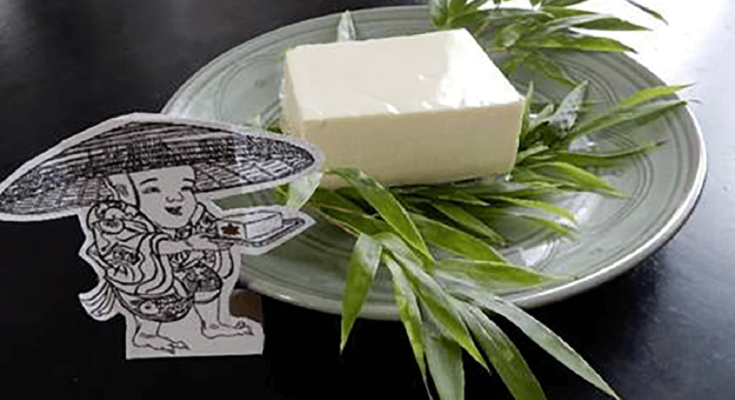Have you ever seen me on a rainy night? I’m Tofu Boy 豆腐小僧, one of the Japanese specters. I show up on a rainy night and offer tofu to anyone who walks by. I often walk after humans, but don’t worry, I don’t do anything bad. In fact, I am sad to say that it is hard for me to show up these days because there are so many brightly lit night streets in Japan. So today, I’m going to use this HTJ to recommend tofu goodness to you all.
Tofu originated in China about 2,200 years ago. During the Nara period (710-794), the method of making tofu was introduced, and it spread throughout Japan during the Muromachi period (1333-1573), becoming a huge boom during the Edo period (1603-1868). Needless to say, it is now one of Japan’s national foods.
1. How to Make Tofu

Tofu is made from soybeans, water, and bittern. Tofu tastes different depending on the type of soybeans and the water used. It’s fun to compare them with each other because they are different depending on where they were made.
- Soak soybeans in water and crush them into small pieces.
- Heat soybeans.
- Wrap in cloth and squeeze out soy milk.
- Add bittern to soy milk, place in a mold and wait for it to harden. After the soy milk is squeezed out, tofu is completed in several processes. This process differentiates the different types of tofu. Yuba 湯葉 and okara おから, which are produced in the process of making tofu, can also be eaten with relish.


2. Types of Tofu


- Kinugoshi dofu 絹ごし豆腐・・・Put the soy milk directly into the mold and wait until it hardens, then remove it from the mold and let it soak in water. Softer than momen dofu.
- Momen dofu 木綿豆腐・・・After hardening, break it down and reshape it again.
- Yose dofu 寄せ豆腐 (Oboro dofu おぼろ豆腐)・・・Scooping the beginning of solidification and omitting the process of soaking in water.
- Shima dofu 島豆腐・・・Also known as Okinawan tofu. It is made by adding bittern to soy milk, simmering it, placing it in a mold, and then weighing it down to drain well, so it is harder than other tofu.

- Egg tofu (Tamago dofu) 卵豆腐 / Sesame tofu (Goma dofu) ごま豆腐・・・These are not strictly tofu because they don’t use soybeans. Eggs and sesame seeds are used instead of soybeans to create a tofu-like texture.
※When reading “~ tofu”, it is pronounced “~ dofu.”
3. Nutritional Value of Tofu
In addition to protein, which is a key nutrient, tofu contains many other ingredients that are good for you. Some of them are presented below.
- Protein: Lowers cholesterol and inhibits elevated blood pressure.
- Isoflavone: Prevents osteoporosis and menopause, which is thought to be one of the causes of decrease of female hormones.
- Calcium (Ca): Nutrient that builds bones, teeth, etc. and is also important for controlling feelings.
- Lecithin: It can dissolve cholesterol and prevent it from adhering to blood vessels.
- Saponin: Nutrients that help prevent fat accumulation, adult diseases and aging, and improve bowel movements
As mentioned above, tofu is a nutrient-rich food, but be careful not to eat too much. If you overeat, you will be nutritionally unbalanced. In fact, one of my colleagues was eating only tofu for lunch to lose weight, but she lamented that she couldn’t lose weight.
4. Dishes with Tofu
Since tofu is made from soybeans, it has a light flavor. So it can be transformed into a variety of dishes depending on how it is cooked. The food preparation of tofu is heating it or eating it raw, but the nutritional difference due to heating is negligible. I’ll introduce some typical tofu dishes that are seasonal and regional dishes in Japan.
■Summer >> Hiyayakko 冷や奴

The simplest way to eat it is to top it with chopped green onions, shiso or grated ginger and pour soy sauce over it, but you can add any toppings you like. It is a simple dish that can be enjoyed even in the hot and humid Japanese summer because it’s delicious with a smooth taste.
■Winter >> Yudofu 湯豆腐

A way to eat tofu and green onions, etc. in a hot pot. In the cold winter, this way of eating warms your body and shows the goodness of the ingredients. Originally, this dish was developed as a shojin ryori in temples. Yudofu restaurants around Nanzenji Temple in Kyoto are very famous. It also comes with other dishes, giving you a taste of Kyoto. You’ll enjoy the typical Kyoto taste.
■Shojin ryori 精進料理

In Buddhism, there is a precept not to eat animal protein, because it is a form of killing. It developed from the diet of Zen Buddhist monks during the Kamakura period. Tofu made from soybeans, also known as “meat of the field” is an indispensable ingredient. For vegetarians, it is a good ingredient, but vegans should be aware of it because the broth may be made with animal protein.
■Goyachanpuru ゴーヤチャンプル:Typical Okinawan Tofu Dish

Tofu, bitter gourd, pork, and egg stir-fried together. It is best to use hard shima dofu for this dish. The contrast between the bitter taste of a goya and the other ingredients stimulates the appetite, and it is a useful dish that helps prevent summer fatigue.
■Mabo dofu 麻婆豆腐:A staple of Chinese cuisine

Stir-fried minced meat and tofu with chili peppers. One of the typical Chinese dishes. It is one of the familiar dishes for Japanese people. The light flavor of tofu and spicy chili mixes well, and it makes your mouth water.
5. Tofu Restaurant Recommendation
“Umenohana 梅の花“ specializes in tofu cuisine and is a nationwide chain of stores is in Japan. You can enjoy a variety of tofu dishes at affordable prices for lunch. Kaiseki meals 会席料理 with meat and fish are available, and vegetarian dishes rich in soy and vegetables are also available.
http://www.umenohana.co.jp/shop

On a final note, I’d like to thank everyone for reading this blog, and I hope you learned more about the goodness of tofu. Tofu is rich in nutrients and can be transformed into a variety of flavors depending on how you cook it. You can easily buy them in supermarkets, and sometimes you can even try them in restaurants. I hope you’ll eat tofu and be healthy!
Business training instructor. I’m originally from Takarazuka in Hyogo Prefecture in the Kansai area. Now I live in Yokohama. I love exercising, traveling, watching movies, art, and nature.





 HTJ has a YouTube page! Check it out
HTJ has a YouTube page! Check it out